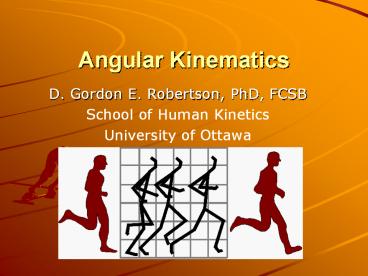Angular Kinematics PowerPoint PPT Presentation
1 / 16
Title: Angular Kinematics
1
Angular Kinematics
- D. Gordon E. Robertson, PhD, FCSB
- School of Human Kinetics
- University of Ottawa
2
Angular KinematicsDifferences vs. Linear
Kinematics
- Three acceptable SI units of measure
- revolutions (abbreviated r)
- degrees (deg or º, 360º 1 r)
- radians (rad, 2p rad 1 r, 1 rad 57.3 deg)
- Angles are discontinuous after one cycle
- Common to use both absolute and relative frames
of reference - In three dimensions angular displacements are not
vectors because they do not add commutatively - (i.e., a b ? b a)
3
(No Transcript)
4
Absolute or Segment AnglesUses Newtonian or
inertial frame of reference
- Used to define angles of segments
- Frame of reference is stationary with respect to
the ground, i.e., fixed, not moving - In two-dimensional analyses, zero is a right,
horizontal axis from the proximal end - Positive direction follows right-hand rule
- Magnitudes range from 0 to 360 or
- 0 to /180 (preferably 0 to /180) deg
5
Angle of Foot
6
Angle of Leg
7
Relative or Joint AnglesUses Cardinal or
anatomical frame of reference
- Used to define angles of joints, therefore easy
to visualize and functional - Requires three or four markers or two absolute
angles - Frame of reference is nonstationary, i.e., can be
moving - Origin is arbitrary depends on system used,
i.e., zero can mean neutral position (medical)
or closed joint (biomechanical)
8
Angle of Ankle
9
Angle of Knee
10
Absolute vs. Relative
- knee angle
- thigh angle
- leg angle 180
- 60(120)180
- 120
11
Joint Angles in 2D or 3D
- q cos1(ab)/ab
- a and b are vectors representing two segments
- ab product of segment lengths
- ab dot product
12
Angular KinematicsFinite Difference Calculus
- Assuming the data have been smoothed, finite
differences may be taken to determine velocity
and acceleration. I.e., - Angular velocity
- omegai wi (qi1 qi-1) / (2 Dt)
- where Dt time between adjacent samples
- Angular acceleration
- alphai ai (wi1 wi-1) / Dt (qi2 2qi
qi-2) / 4(Dt)2 - or ai (qi1 2qi qi-1) / (Dt)2
13
3D AnglesEuler Angles
- Ordered set of rotations
- a, b, g
- Start with x, y, z axes
- rotate about z (a) to N
- rotate about N (b) to Z
- rotate about Z (g) to X
- Finishes as X, Y, Z axes
14
Visual3D AnglesSegment Angles
- Segment angle is angle of a segment relative to
the laboratory coordinate system - x, y, z vs. X, Y, Z
- z-axis longitudinal axis
- y-axis perpendicular to plane of joint markers
(red) - x-axis orthogonal to
- y-z plane
15
Visual3D AnglesJoint Cardan Angles
- Joint angle is the angle of a segment relative to
a second segment - x1, y1, z1 vs. x2, y2, z2
- order is x, y, z
- x-axis is flexion/extension
- y-axis is varus/valgus, abduction/adduction
- z-axis is internal/external rotation
16
Computerize the Process
- Visual3D, MATLAB, Vicon, or SIMI etc.

